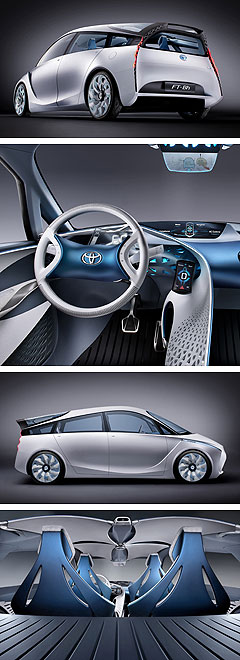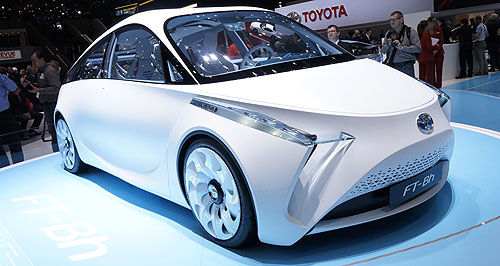Make / Model Search
Future models - Toyota - FT-BhGeneva show: Toyota hybrid cracks 50g/kmFrugal: The Toyota FT-Bh hybrid concept may look decidedly oddball, but it sets economy and emissions benchmarks. Toyota upstages Hyundai and Yaris hybrid with concept that returns just 2.1L/100km7 Mar 2012 By MARTON PETTENDY in GENEVA TOYOTA has set a new efficiency benchmark by revealing a light-size (B-segment) hybrid hatchback that consumes just 2.1 litres of petrol per 100km and emits only 49 grams of CO2 per kilometre. The figures undercut similarly sized city-hatches, including Hyundai’s facelifted i20, which emits just 84g/km from a new 1.1-litre three-cylinder diesel engine, and Toyota’s own Yaris hybrid, which emits only 79g/km and also made its world debut at this week’s Geneva show before hitting European roads in May. However, neither the i20 Blue Drive diesel nor the Yaris hybrid will be sold in Australia – where next month the new pint-size Prius C hatch is likely to eclipse the regular Prius (89g/km) as the nation’s most environmentally friendly new car – while the fuel-sipping FT-Bh is for now just a concept. The super-efficient FT-Bh was bookended in Geneva by the FCV-R concept, which debuted at last year’s Tokyo show and previews the fuel cell vehicle future Toyota has committed to making reality by 2015 (before selling “tens of thousands” of FCVs in the 2020s), and the coupe-like NS4 hybrid sedan concept that previews the next Camry’s styling.  It was previewed by a sketch and two teaser images last month, when Toyota promised the glass-backed five-door FT-Bh (which stands for Future Toyota B-segment hybrid) would offer the interior space of a light hatch like the Yaris while emitting 50 per cent less CO2. It was previewed by a sketch and two teaser images last month, when Toyota promised the glass-backed five-door FT-Bh (which stands for Future Toyota B-segment hybrid) would offer the interior space of a light hatch like the Yaris while emitting 50 per cent less CO2.Now Toyota has revealed the full-hybrid FT-Bh four-seater consumes just 2.1L/100km and emits only 49g/km – the same figures achieved by the Prius Plug-In Hybrid, which offers a 25km of zero-emissions driving range and goes on sale in Europe in mid-2012 but is yet to be confirmed for Australian release. It said the key to cutting the standard petrol Yaris’ consumption by some 50 per cent was combining a 25 per cent lower (sub-800kg) kerb weight with 30 per cent better (0.235Cd) aerodynamics and a downsized (1.0-litre twin-cylinder) petrol-electric drivetrain, without resorting to exotic materials or expensive production techniques. Toyota claims the result is benchmark-setting (non-plugin) efficiency from a full-hybrid vehicle that is longer than a Yaris but employs economically viable technologies and is built at a cost “appropriate for a high-volume B-segment car”, giving it solid production potential. Although Toyota continues to favour petrol-electric propulsion over diesel power – at least in its passenger car models – it said the flexibility of its Hybrid Synergy Drive system could see potential compressed natural gas hybrid and plug-in hybrid versions produce even lower carbon emissions at just 38g/km (CNG-HV) and 19g/km (PHEV). Toyota said the ultra-light and slippery FT-Bh show car, which uses about half as much fuel (almost 135mpg in the old money) as Europe’s 1.0-litre petrol Yaris – measures 3985mm long, 1695mm wide and 1400mm tall, and rides on a 2570mm wheelbase. Apart from reducing mass and both air and road resistance, Toyota engineers focused on powertrain efficiency, thermal energy management and electricity use by ancillary powertrain components. Aerodynamics were optimised by maximising the car’s glass area via the use of thin roof pillars, while Toyota’s target of reducing the 1.0-litre Yaris’ 1030kg kerb weight by a quarter was achieved with the use of high-tensile steel, aluminium and magnesium, resulting in a Smart ForTwo-beating total mass of just 786kg. Toyota said that to achieve its weight reduction target the combined mass of the bodyshell, interior trim, chassis and electronics had to be reduced by around 340kg – or one third of Yaris’s weight – because the two-cylinder hybrid powertrain is heavier than the triple-cylinder 1.0-litre Yaris engine (about 60kg). However, it points out the FT-Bh’s new 1.0-litre Atkinson-cycle twin not only combines high efficiency with low thermal capacity and internal friction, but weighs almost 90kg less than the 1.8-litre petrol-electric drivetrain in the conventional Prius. While the FT-Bh could preview a future light-sized Toyota hybrid beyond the Yaris hybrid, for now the Japanese giant is ramping up production of the latter by adding a third shift at its Yaris plant in France. Hybrid vehicle sales have not met expectations in Australia, but Toyota has sold more than 400,000 petrol-electric models in Europe and expects to sell its four millionth worldwide in the next few months.  Read more23rd of February 2012  Geneva show: Two new Toyota FT-Bh teasersToyota continues pre-Geneva drip-feed with more pictures of light-sized FT-Bh hybrid15th of February 2012  Toyota Prius C to be Australia’s cheapest hybridYaris-sized Toyota Prius C to undercut Honda Insight as cheapest hybrid Down Under13th of February 2012  Geneva show: Toyota sketches FT-Bh city-car conceptJapanese giant Toyota targets low emissions without the price tag with FT-Bh concept11th of January 2012  Detroit show: Toyota NS4 sets style for CamryToyota designers put their stamp on coupe-like concept for 2015 mid-sizer11th of January 2012  Detroit show: New direction for Toyota hybridNon-Prius mid-size NS4 concept showcases Toyota’s plug-in hybrid future – and moreAll future models Alfa Romeo Alfa Romeo Abarth Abarth Alpine Alpine Alpina Alpina Audi Audi Aston Martin Aston Martin BMW BMW Bentley Bentley Chery Chery Brabham Brabham Chrysler Chrysler Chevrolet Chevrolet Cupra Cupra Citroen Citroen DS DS Dodge Dodge Fiat Fiat Ferrari Ferrari Foton Foton Ford Ford Great Wall Great Wall FPV FPV Haval Haval GWM GWM Honda Honda Holden Holden Hummer Hummer HSV HSV Infiniti Infiniti Hyundai Hyundai Jaguar Jaguar Isuzu Isuzu Kia Kia Jeep Jeep Land Rover Land Rover Lamborghini Lamborghini Lexus Lexus LDV LDV Mahindra Mahindra Lotus Lotus Mazda Mazda Maserati Maserati Mercedes-AMG Mercedes-AMG McLaren McLaren MG MG Mercedes-Benz Mercedes-Benz Mitsubishi Mitsubishi Mini Mini Opel Opel Nissan Nissan Peugeot Peugeot Pagani Pagani Proton Proton Porsche Porsche Renault Renault Ram Ram Rover Rover Rolls-Royce Rolls-Royce Skoda Skoda Saab Saab SsangYong SsangYong Smart Smart Suzuki Suzuki Subaru Subaru Toyota Toyota Tesla Tesla Volvo VolvoMotor industry news |
Click to shareToyota modelsResearch Toyota All future models Alfa Romeo Alfa Romeo Abarth Abarth Alpine Alpine Alpina Alpina Audi Audi Aston Martin Aston Martin BMW BMW Bentley Bentley Chery Chery Brabham Brabham Chrysler Chrysler Chevrolet Chevrolet Cupra Cupra Citroen Citroen DS DS Dodge Dodge Fiat Fiat Ferrari Ferrari Foton Foton Ford Ford Great Wall Great Wall FPV FPV Haval Haval GWM GWM Honda Honda Holden Holden Hummer Hummer HSV HSV Infiniti Infiniti Hyundai Hyundai Jaguar Jaguar Isuzu Isuzu Kia Kia Jeep Jeep Land Rover Land Rover Lamborghini Lamborghini Lexus Lexus LDV LDV Mahindra Mahindra Lotus Lotus Mazda Mazda Maserati Maserati Mercedes-AMG Mercedes-AMG McLaren McLaren MG MG Mercedes-Benz Mercedes-Benz Mitsubishi Mitsubishi Mini Mini Opel Opel Nissan Nissan Peugeot Peugeot Pagani Pagani Proton Proton Porsche Porsche Renault Renault Ram Ram Rover Rover Rolls-Royce Rolls-Royce Skoda Skoda Saab Saab SsangYong SsangYong Smart Smart Suzuki Suzuki Subaru Subaru Toyota Toyota Tesla Tesla Volvo VolvoMotor industry news |











Facebook Twitter Instagram